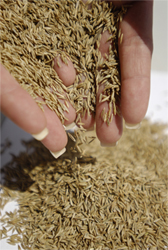No two bags of grass seed are created equal, which can make knowing what type to purchase a challenge. Push past all the marketing gimmicks and fancy wording—and choosing grass seed is all about reading the specifics on the label in order to have a healthy lawn.
Grass seed labels can include a mix of numbers, percentages and industry terminology. Below, we decipher the most common items found on a seed label so that you can make smart decisions when it comes to learning how to pick the right type of grass seed or hiring a company to put seed down for you.
Plus, reading seed labels and choosing grass seed carefully can help you grow a lush lawn that naturally keeps weeds at bay (even those pesky winter weeds).
Reading a Seed Label
Pure Seed/Purity
Purity is the percent, by weight, of pure seed of each component in the mixture. Not all the pure seed is live seed. Look for percentages over 97.5—the higher the better.
Variety/Kind
Variety is the specific type of grass included. Do not buy seed that does not list the variety. Variety not stated (VNS) seed lots often include older varieties not well adapted to lawns.
Germination
Tells how much of each pure seed variety included will sprout (the amount of live seed in the bag). Look for percentages over 80—the higher the better.
Crop
Crop is the percent, by weight, of seeds in a package that are grown as a cash crop. Examples may include orchardgrass, timothy, clover, redtop and bentgrass, which are considered weeds in turf. Look for seed with a crop of less than 0.3%—the lower the better.
Inert Matter
Inert matter is the percent, by weight, of material not capable of growth (i.e. filler). Filler can be any substance added to take up space. For example: broken seed that couldn’t be removed, dirt, corn cobs, sand, etc. Look for the percentage to be less than 2—the lower the better. Otherwise, you’re paying for “junk”!
Weed Seed
Weed seed is the percent, by weight, of weed seed in a package. It can be difficult and expensive to catch all weed seeds during the cleaning process. Acceptable limits range from 0.0% - 0.3%. The lower the percentage of weed seed, the higher the quality of grass seed.
Noxious Weed
Most states have certain weeds so troublesome and undesirable that a tally of their presence in the seed mixture is required on the seed label. You want a seed that reads “NONE” under this category.
Picking the Right Seeds Is a Robust Defense Against Weeds
You should read seeds labels closely so that you select the optimal variety for the given season and climate. A thriving, dense-growing lawn will naturally crowd out weeds. For example, lawns planted with warm-season grass seed (such as Bermuda grass, Centipede grass, and St. Augustine grass) are vulnerable to henbit. Henbit is an annual winter weed. It often takes hold in patchy spots in a lawn where the grass grows less densely.
Key Takeaways: How To Pick Grass Seed
- Buy certified grass seed—it’s guaranteed by the seller to give you the kind of seed named on the package.
- Generally speaking, the higher the cost of grass seed, the higher the quality of product.
- Avoid…
- Buying seed out of bulk bins
- Seed mixes containing annual ryegrass
- Contractor type blends of ryegrass
If you have any questions about reading a seed label or signing up for an aeration and seeding service, get in touch with your local NaturaLawn of America expert.








